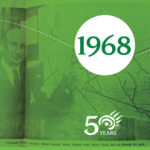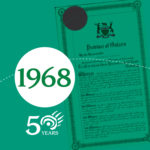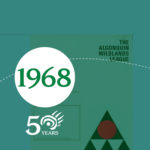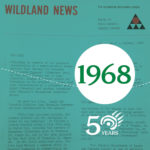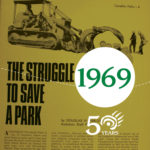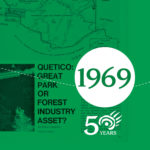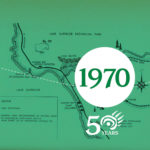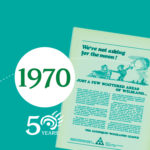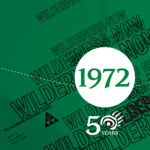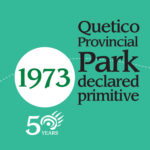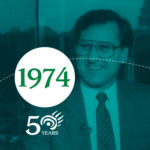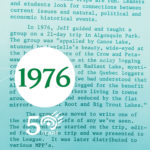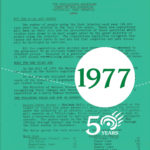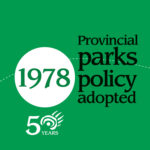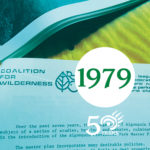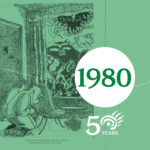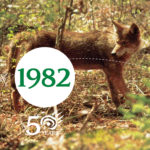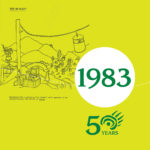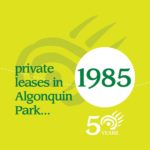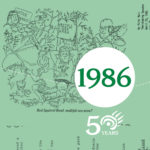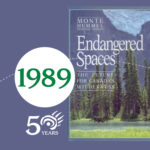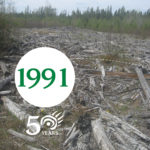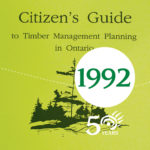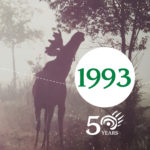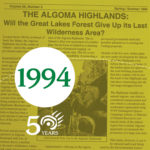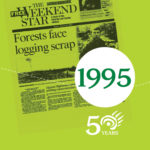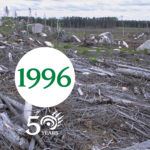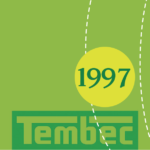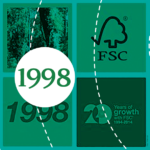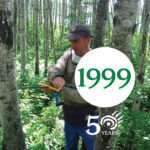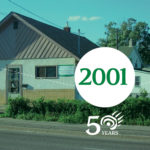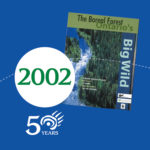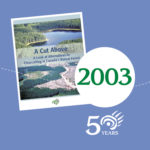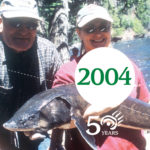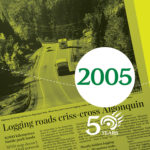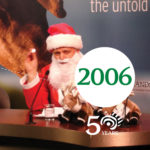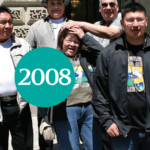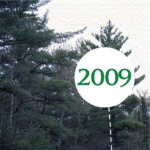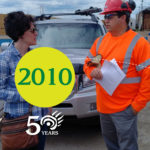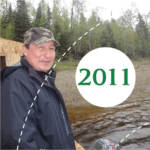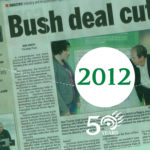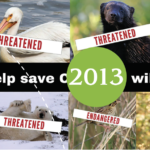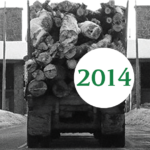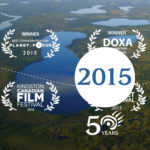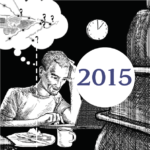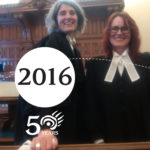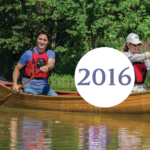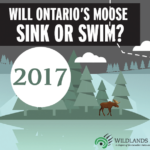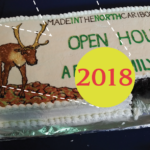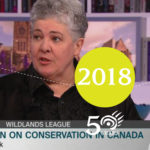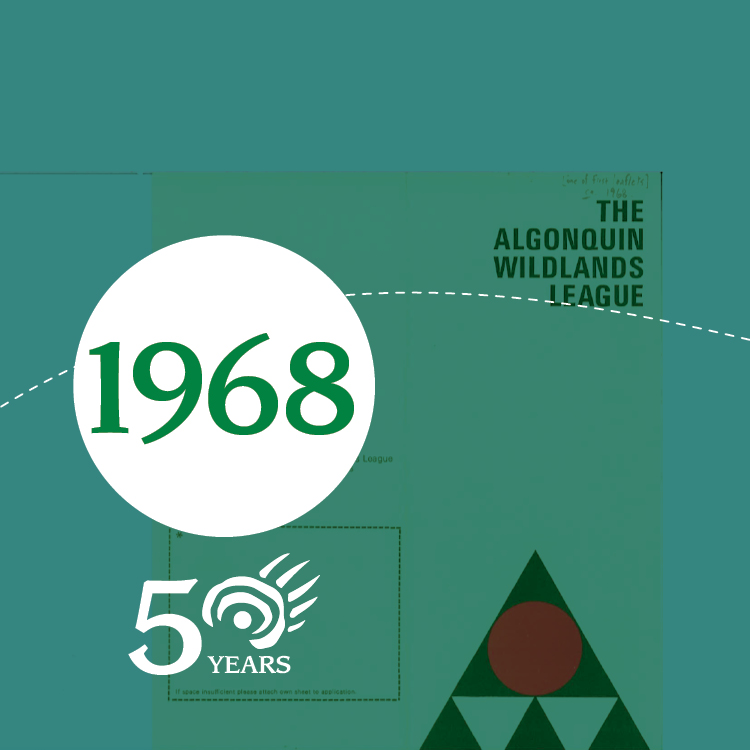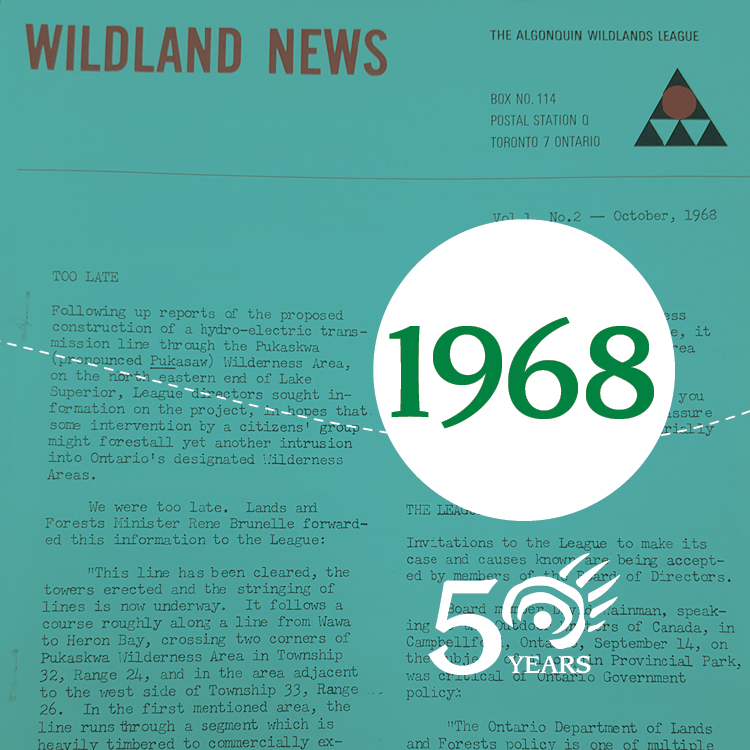50 Years
Wildlands League is celebrating its 50th anniversary! Check out our tracks across Canada in the past 50 years. Click the image below to download our special, limited edition poster.
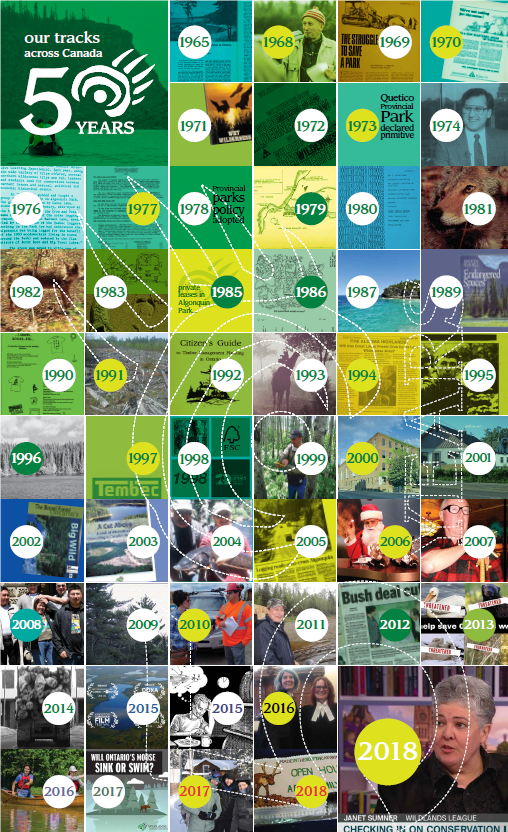
While we aren’t able to present all the things we’ve done in our 50 year journey, we’ve chosen a memorable event from each of our 50 years to share with you. We hope you enjoy these moments we’ve selected.
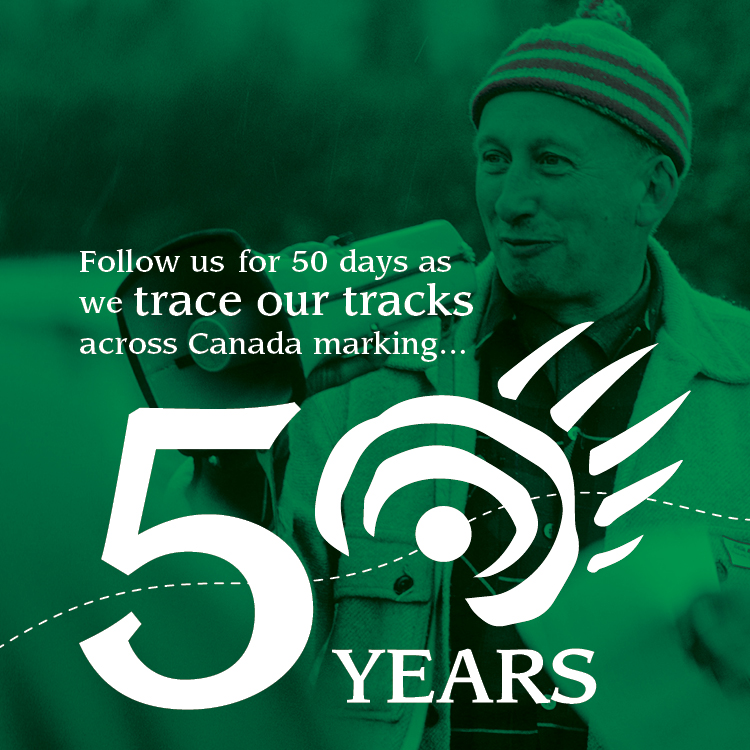
Wildlands League is celebrating its 50th birthday. To commemorate this important milestone, the Wildlands team is travelling back in time to present our wilderness history to you! We travelled to Peterborough and London for books, historical records and media clippings on our organization. We interviewed historians, the families of the original founders and past leaders. Join us for the next 50 days as we trace our roots from the 1960s and work our way right up to the present. #50WildYears #GoWildON. Photo Courtesy of Bruce Litteljohn.
Internationally recognized University of Toronto Zoology Professor Douglas Pimlott, who spearheaded wolf research for the Ontario Department of Lands and Forests, became increasingly concerned about the lack of planning and protection of parks in Ontario, and in particular Algonquin Provincial Park. In 1965, he issued a clarion call to preserve wilderness as natural areas in Ontario. He called it “Preservation of Natural Areas in Ontario” and it was published in The Ontario Naturalist. This triggered a “preservationist upsurge” which led to multiple discussions in the next three years on the creation of an environmental group that would reignite the conversation on preserving parks in Ontario. That environmental group would be Algonquin Wildlands League. Thanks to Ontario Nature for digging up this 1965 article from their then Ontario Naturalist magazine. (Sources: Killan G. and Warecki G. 1989. The Algonquin Wildlands League and the Emergence of Environmental Politics in Ontario, 1965 – 1974. Vol. 16. No. 4. p. 1-27).
Read more here: https://bit.ly/2zJHmEu
On March 13th, 1968, Abbott Conway, a businessman from Huntsville and one of the future founders of the League, presents to the Standing Committee of the Ontario Legislature on Natural Resources and Tourism on his submission concerning the zoning of Algonquin Park. He argues that primitive zones in parks serve “to set aside representative areas of natural landscapes of scientific quality for posterity and to provide an opportunity to enrich and expand the outdoor knowledge and recreational experience of park visitors in natural wild conditions, and to provide an outdoor laboratory for non-destructive scientific study”. (Sources: Warecki,G 1989, Protecting Ontario’s Wilderness: A history of changing ideas and preservation politics, 1927 – 1973. The Canadian Historical Review,University of Toronto Press. Vol. 8. p. 159; Conway, 1968, p. 4)
On June 1st, 1968, Algonquin Wildlands League holds its inaugural meeting as an official non-profit environmental group, consisting of 11 members. Environmental historian George Warecki, wrote in 1989, “Naturalists, scientists, recreationists, and environmentalists joined forces to publicize the need for preservation. The awakening spawns a new pressure group – the Algonquin Wildlands League”. The League champions a “wilderness free of interference with ecological processes especially resource extraction and recreational overuse”. With the emergence of the Wildlands League, there is a shift from ‘quiet diplomacy” to ‘mass media techniques’ with the latter being the foundation of “Ontario’s modern wilderness preservation movement”. (Sources: Wildlands News, 1980 Vol 22, No. 1; Warecki,G 1989, Protecting Ontario’s Wilderness: A history of changing ideas and preservation politics, 1927 – 1973. The Canadian Historical Review,University of Toronto Press. Vol. 8. p. 6).
One of the League’s first order of business is to launch a campaign to remove commercial logging from Algonquin Park. Abbott Conway, president of the League, also issues “the Algonquin Alert” and invites the public to report any activity which violates the public’s wilderness values. Wildlands League keeps Algonquin Park in the news spotlight for two months. Historians writes about this time period, “Never before in Canada had wilderness issues received such media coverage”. This marks the end of the era characterized by some as “quiet diplomacy” on park protection, and the beginning of “mass media techniques” and a “broad-based preservation movement”. (Killan G. and Warecki G. 1989. “The Algonquin Wildlands League and the Emergence of Environmental Politics in Ontario, 1965 – 1974”. Vol. 16. No. 4. p. 1-27; Warecki, G. 2017. Environmental Coalitions and The Limits of Science: Wilderness Advocacy in Ontario during the 1970s. Vol. 109. No. 1, p. 60 – 88).
TOO LATE – In October of 1968, just 4 months after Algonquin Wildlands League’s inaugural meeting, Wildlands reports to its members that it is too late to stop the construction of a hydro-electric transmission line through what was then the Pukaskwa Wilderness Area. Reflecting the sentiment of the time, Lands and Forest Minister René Bruelle releases a statement to ‘assure’ the league that “this line does not materially affect this wilderness area”. This transmission line lives on to fragment Pukaskwa National Park (and be an outstanding problem for the League in 2018). (Sources: Wildlands News, 1968, Vol. 1, No. 2).
By 1969, news media on Algonquin Park reaches an overwhelming magnitude. In an attempt to “put a lid” on the controversy around the industrial activities in Algonquin Park, the provincial government appoints a committee – the Algonquin Advisory Committee – to manage the situation. Algonquin Wildlands League is invited to be a member of this committee.
Meanwhile, the League launches new campaigns to eliminate logging from Killarney Provincial Park and Quetico Provincial Park, the latter spearheaded by one of the league’s founders Bruce Litteljohn. These campaigns begin in 1969 and span into the 70s. The league circulates more than 1,000 copies of information packages on Quetico Park to the public, which encouraged the formation of several “Save Quetico” groups. (Sources: Warecki, G. 1993. The People Behind the Parks: Ontario’s Wilderness Conservationists. In: Islands of Hope. Firefly Books Ltd. p. 82).
In 1970, Algonquin Wildlands League starts a new battle: the campaign to end logging in Lake Superior Provincial Park. After an investigation, the League uncovers that two logging companies had timber licenses that covered 500 of the park’s 526 square miles. This would have meant that 95% of the crown timber licenses in the park are held by just two U.S. based logging companies. (Sources: Litteljohn B. and Pimlott, D. 1974. Why Wilderness? A report on mismanagement in Lake Superior Provincial Park. Chicago, Illinois).
1971 brought success and disappointment to the League. Killarney Provincial park became classified as a “primitive park”, meaning that it would be free of logging and mechanized recreation. In the same year, logging was prohibited in Quetico Provincial Park. Ontario also signs an agreement to finally make Pukaskwa National Park. The league was disappointed that the Frost Advisory Committee released a report on Algonquin Park, which prohibited motorboats and snowmobiles in the park but allowed logging to continue. (Sources: Killan G. and Warecki G. 1989. The Algonquin Wildlands League and the Emergence of Environmental Politics in Ontario, 1965 – 1974. Vol. 16. No. 4. p. 18).
By 1972, the league publishes “Wilderness Now”, a seminal booklet which articulated the group’s wilderness philosophy and recommendations to achieve wilderness preservation. Historians Killan and Warecki describe this as “a noteworthy first attempt to define a wilderness preservation policy for Ontario, and stimulated park planners to follow suit” (Source: Killan G. and Warecki G. 1989. The Algonquin Wildlands League and the Emergence of Environmental Politics in Ontario, 1965 – 1974. Vol. 16. No. 4.).
In 1973, Quetico Provincial Park is declared a primitive Park, meaning that it would be free of logging and mechanized recreation. As historians describe it, “The battle of Quetico wilderness had been won”. This success is achieved through 263 written briefs, 4,500 letters, and 144 oral presentations received from the public by the Citizen’s Advisory Committee on the park (Warecki, 1989). Of note, Pollution Probe works with the league and runs full-page ads at the time in the Toronto Telegram. Meanwhile, the battle to end commercial logging in Algonquin Park continues as 77% of the park remains open to logging. (Source: Warecki,G 1989, Protecting Ontario’s Wilderness: A history of changing ideas and preservation politics, 1927 – 1973. The Canadian Historical Review,University of Toronto Press. Vol. 8. p. 18).
In 1974, Ontario NDP Leader Stephen Lewis speaks out about Algonquin Park: “The truth is that we don’t need to log the park; we shouldn’t be logging the park, and now is the time to begin the phasing out process”. In the same year, the first ever Algonquin Park Master Plan is completed. This plan is met with disappointment by the Algonquin Wildlands League as it allowed logging to continue in the park, while approximately 9% of the park is zoned “primitive” (meaning that it would be free of logging and mechanized recreation) and ignored the park’s unique ecological features. Photo from National Post. (Source: Statement by Stephen Lewis, Ontario NDP Leader, on Algonquin Park. Statement dated September 27, 1974).
Aside from campaigns, the Algonquin Wildlands League often led hikes and trips to nature. In 1976, Jeff Miller, one of the League’s founding members, leads a group on a 21-day trip to Algonquin Park. The group document their experience at the park. (Wildlands News Nov 1977, Vol. 9 No. 2).
Over the next five years the number of visitors to Algonquin Park doubles. To deal with the influx, new regulations are put in place by Ontario in 1977. Meanwhile, Algonquin Wildlands League is still fighting to end commercial logging in the park. (Source: original statement: New Regulations affecting users of the Algonquin Park Interior 1977).
Algonquin Wildlands League’s efforts lead to the Davis government approving the Ontario Provincial Parks Planning and Management Policies manual, or the “Blue Book”, adopted in 1978. Under this policy the government would be committed to establishing a slew of wilderness parks in Ontario. In the same year, Pukaskwa land is transferred from Ontario to Canada in the process of becoming a national park. (Killan G. 1993. Protected Places: A History of Ontario’s Provincial Parks System, Dundurn, Quebec, Canada. p. 353).
1979 saw a shift in the league’s strategy. With a less-than-satisfactory final plan for Lake Superior Provincial Park that prohibited logging to only 50% of the park, the league decides to focus its efforts instead to creating a system of primitive parks (later known as wilderness parks). The League forms the “Coalition of Wilderness” with the Canadian Nature Federation (now Nature Canada) and the Federation of Ontario Naturalists (now Ontario Nature), who send the first 5-year review brief of the Algonquin Parks Master Plan to the Ontario Provincial Parks Council. (Source: Warecki,G 1989, Protecting Ontario’s Wilderness: A history of changing ideas and preservation politics, 1927 – 1973. The Canadian Historical Review,University of Toronto Press. Vol. 8. p. 20).
1980 Algonquin Wildlands League joins The Canadian Parks and Wilderness Society or CPAWS (then known as the National and Provincial Parks Association of Canada). The league and organizers of “Action Seminar on Acid Precipitation” release recommendations to the Canadian government focusing on sulfur dioxide emissions. Image from Wildlands News March 1983 Vol 15 No 2. (Source: Wildlands League and NPPAC contract).
In 1981, Ontario regional park officials produce documents which identify 245 candidate provincial parks that meet the “Blue Book” standards for each class of park. This rationale for expanding parks encourages politicians to double the provincial parks system and manage it according to the guidelines of the “Blue Book”. (Sources: Killan, G. 1993. Ontario’s Provincial Parks, 1893 – 1993: “We make progress in jumps” in Islands of Hope.)
Algonquin Wildlands League and 7 other environmental NGOs organize local action committees about the Strategic Land Use Planning constructed by the Ministry of Natural Resources. These take form in 141 open houses, and is attended by 10,000 people. (Killan G. 1993. Protected Places: A History of Ontario’s Provincial Parks System, Dundurn, Quebec, Canada. p. 353
In 1983, Algonquin Wildlands League celebrates the creation of 5 new wilderness parks: Woodland Caribou Park, Wabakimi Park, Lady Evelyn-Smoothwater Park, Opasquia Park and Kasagmi Park. That same year, the league meets with Premier Bill Davis to discuss the creation of Bruce Peninsula National Park. (Image and source from Wildlands News Fall 1986 Vol 18 No 4.)
League accepts a compromise on private leases in Algonquin to end in 2017 however gov would renew them years later without a similar level of public consultation.
We begin operating as Wildlands League to expand on work beyond Algonquin Park.
After relentless campaigning alongside Ontario Nature and CPAWS, Bruce Peninsula National Park is created.
Endangered Spaces campaign launches. Doug Pimlott is honoured in book, edited by Monte Hummel, called Endangered Spaces: the future for Canada’s wilderness.
League sells tree themed t-shirts and mugs, & ‘essays on ecology’ for the holiday season.
Wildlands in a coalition, represented by Canadian Environmental Law Association, participates in the Timber Class EA
hearings, which span from 1988 to 1992.
End of timber hearings, would lead to new law and fundamental shift in approach to forestry. New consensus:
forest is a complex ecological system with many values, not just a provider of wood products.
Wildlands and allies fight harmful railway expansion in Algonquin Park which could lead to 50 moose fatalities each year, increased risk of toxic spills, and air and water pollution in the park.
Wildlands News calls on supporters to protect the Algoma Highlands.
Tim Gray then E.D., fights for Algoma Highlands home to last remaining old growth hardwood and white pine forests in North America. League prevails as CN Railway abandons Algonquin Rail expansion.
League achieves big environmental victory after court agrees with them that 6 forest management plans are illegal because they did not meet sustainability requirements set out in law.
Partnership for Public Lands begins. And Wildlands League also begins long lasting friendship and partnership with forest company Tembec (now known as Rayonier Advanced Materials).
Wildlands League is instrumental is developing Forest Stewardship Council Certification (FSC) globally.
Wildlands through PPL establishes 2.4 million ha of protected areas thereby doubling the area covered by parks in northern and central Ontario.
League moves into 401 Richmond W. where we still operate out of today. We also publish a discussion paper
on how to end logging in Algonquin Park while protecting jobs.
We open our Thunder Bay office.
League, Ontario Nature & WWF publish Big Wild, a 12 page full colour doc highlighting importance of boreal forest
and work with First Nations.
League publishes two national reports on: alternatives to clearcutting in Boreal Forests and Aboriginal values in
protected areas in Canada.
League disentangles 50,000 ha of parks from mining claims and draws attention to potential mining waste being pumped into Groundhog River Provincial Park home to rare lake sturgeon.
League alerts the public that there are more km of logging roads in Algonquin Park than in the city of Toronto or running between Halifax and Vancouver.
New parks laws is passed enshrining ecological integrity as management priority. Santa Claus and League deliver
caribou toys to Queen’s Park sounding alarm on reindeers’ cousins, boreal caribou.
Long-time Wildlands supporter and wilderness enthusiast, Glen Davis, is honoured posthumously with the Abbott Conway Award.
Wildlands fights unjust Mining Act alongside many others and supports Bob Lovelace & KI Six. Culminates in 1,000
people, teepees, sleepover at Queen’s Park, & victory at Ontario Court of Appeal.
Wildlands League draws public attention to the “wild west free-for-all” mining staking frenzy in the Ring of
Fire.
League plays a lead role in rerouting of transmission line away from intact caribou habitat in Wabakimi Provincial Park.
Tembec, League and First Nations begin co-creating plan for caribou and jobs.
John Cutfeet returns as bilingual (OjiCree- English), Watershed Program Coordinator. League brings journalist to Albany River and is featured in Toronto Star story called Rafting to the Ring of Fire.
League and partners release first ever caribou action plan in Canada covering 3 million ha in northeastern
Ontario. 23,000km2 off limits to mining as a result of KI’s and Wildlands’ efforts to protect lands and waters.
Lightening the Footprint is implemented for Algonquin Park which adds 96,089 ha of protection to the park bringing total protection to 35%. League launches lawsuit to protect species at risk in Ontario.
Wildlands applauds the Environmental Commissioner’s call to end logging in Algonquin Park.
Risks of methylmercury contamination highlighted in Hudson Bay Lowlands and is profiled in a documentary
called After the Last River by Victoria Lean.
Special report published on failures of self-monitoring and self-reporting at the De Beers Victor Diamond Mine in
northern Ontario. League photos reveal extensive damage by Ring of Fire mining exploration.
Making a stand for species at risk at the Ontario Court of Appeal.
After rectifying a critical weakness in law governing Rouge National Urban Park, Prime Minister Justin
Trudeau Paddles the Rouge with League.
Common no more? League calls for end to moose calf hunt and creation of moose refuge areas.
The Cochrane Plan. League hosts family friendly event in Cochrane in support of jobs and caribou. League
fights to remove harmful transmission line from Pukaskwa National Park.
Janet Sumner, current E.D. & co-chair of National Advisory Panel, publishes Canada’s Conservation Vision and speaks with TVO’s Steve Paikin about new $1.3 billion investment for nature by federal government.


